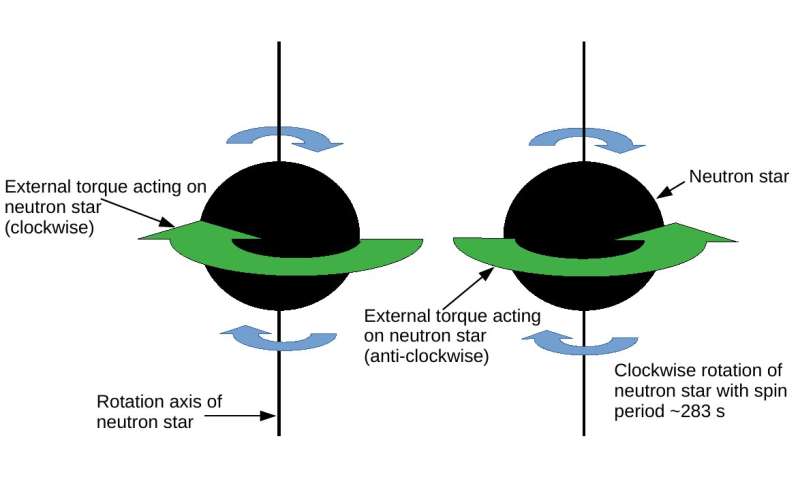Taking the pulse of a neutron star for almost five decades finds nearly cyclic spin changes on long time-scales

The X-ray binary system Vela X-1 consists of a neutron star (which contains as much mass as our sun (~1030 kg), but is very compact and has a radius of ~10 km or so, about the size of a small city) and a supermassive star with a mass of ~23 times of our sun and that is ~34 times bigger in size than our sun. The stars orbit around their common center of mass. The neutron star rotates once every ~283 s and shines brightly in X-rays by accreting gas from the stellar wind emanating from the massive companion star. The captured gas falls in the strong gravitational potential of the neutron star and is funneled along its strong magnetic field, hitting its poles at high velocities, making them hot and generating thermal X-rays during the process. The magnetic axis and the rotation axis of the star are misaligned (like Earth), which generates X-ray pulses akin to a lighthouse beacon.
Exploring the rotation of Vela X-1 for ~46 years using X-ray space observatories since 1975, a team of Indian scientists has constructed the longest known spin period history of an X-ray pulsar. They found that the neutron star shows cyclic changes in spin period on long time scales of about 5.9 years, making Vela X-1 only the third known X-ray pulsar with such a long-term periodicity in spin changes. The pulsar also shows random spin period changes on shorter timescales, which is a hallmark of X-ray pulsars that accrete from the stellar wind from a companion star.
Slowing or speeding a bicycle requires external torque—braking to slow down, or pedaling harder to cycle faster. However, what causes intriguing slowing down or speeding up of a massive neutron star on both short (a few minutes to few days) and long time-scales (a few months to many years) has been a long-standing puzzle, and many attempts have been made to solve it to some extent in different X-ray binary systems. The scientists explore working of "astrophysical brakes" and "pedals" using theoretical models that could make Vela X-1 spin-up or spin-down on cyclic time scales of about 5.9 years. They suggest that the answer to this puzzle is probably blowing in the wind from the companion star! The companion star may itself undergo cyclic changes on time scales of about 5.9 years during which the amount of gas lost from the star changes in a cyclic manner modulating those "astrophysical brakes" and "pedals."

"This discovery opens a new paradigm of exploring spin changes on long time scales in other X-ray pulsars and attempts to understand the underlying phenomena which causes long-term nearly cyclic spin-changes in other X-ray pulsars," said Amar Deo Chandra, lead author on the new study.

This story is part of Science X Dialog, where researchers can report findings from their published research articles. Visit this page for information about ScienceX Dialog and how to participate.
More information:
Amar Deo Chandra, Jayashree Roy, P. C. Agrawal, Manojendu Choudhury, Detection of nearly periodic spin period reversals in Vela X-1 on long time-scales: inkling of solar-like cycle in the donor star?arXiv:2108.07097v1 [astro-ph.HE], arxiv.org/abs/2108.07097
Amar Deo Chandra is a final year PhD student (INSPIRE fellow ) at the Center of Excellence in Space Sciences India (CESSI) , IISER Kolkata. He obtained his Integrated MSc. in Physical Sciences from the UM-DAE Centre for Excellence in Basic Sciences. His current research interests span exploring light in laboratory settings to light/waves emanating from cosmic sources such as X-ray/radio pulsars and massive stars. Besides research, he is passionate about disseminating science to the masses through popular outreach talks, experimental demonstrations, print and the electronic media. amarastro.github.io/